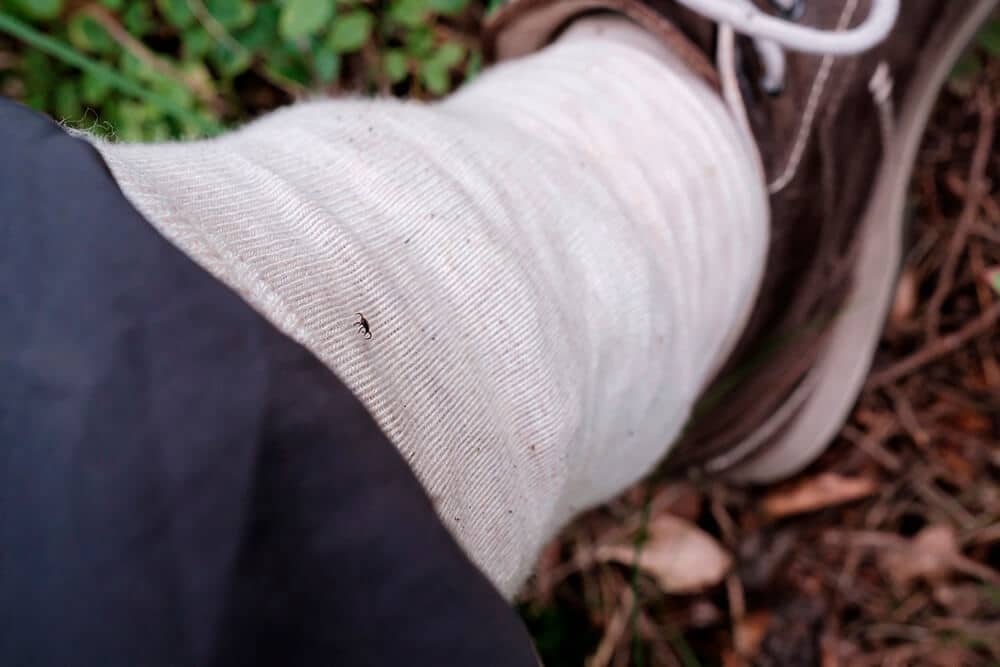Table of Contents
- Hifas da Terra has conducted a study on chronic Lyme (Post Treatment Lyme Disease Syndrome) using Mycotherapy.
- This study aimed to investigate the effects of mycotherapy with Reishi (Ganoderma lucidum) and Lion’s Mane (Hericium erinaceus) for 3 months in people with chronic Lyme disease (PTLDS).
- This study was carried out in association with Déborah Jublin, naturopath and coordinator of the Réseau Lyme Europe association.
Lyme borreliosis: a disabling disease
According to the definition given by the French Ministry of Labour, Health and Solidarity, Lyme disease, or Lyme borreliosis, is transmitted by a tick bite infected with borrelia, a bacterium in the spirochete family. The infection often has no symptoms, but can in some cases lead to a disabling condition (lasting joint pain, partial paralysis of the limbs, etc.). It is important to note that Lyme disease is not contagious. [1]
Post-Treatment Lyme Disease Syndrome (PTLDS) is a condition in which patients experience persistent symptoms of fatigue, pain and cognitive difficulties after 6 months of antibiotic treatment for acute Lyme disease.
Up to 20% of patients with Lyme disease develop PTLDS. By definition, post-treatment Lyme disease syndrome includes a previous diagnosis of Lyme disease, recurrent symptoms of fatigue, musculoskeletal pain or cognitive impairment, which can persist for at least six months after the end of antibiotic treatment.
Although a history of a tick bite or erythema migrans (EM) rash enables rapid diagnosis, few patients are aware they have been bitten by a tick before infection and the incidence of EM rashes varies according to geographical location and Borrelia species, so some patients never develop EM. Chronic manifestations of Lyme disease may therefore result from delays in diagnosis. Chronic manifestations of Lyme disease may also result from failure of antibiotic therapy, as commonly prescribed treatments may not be curative. Researchers have found that patients with acute and/or long-standing Lyme disease often remain ill for long periods after treatment and that some see their disease progress despite treatment. [2]
The chronic manifestations of Lyme disease are associated with significant and lasting alterations in the quality of life in certain patients. The quality of life scores of participants in the four Lyme disease re-treatment trials sponsored by the National Institutes of Health (NIH) were systematically lower than those of healthy populations. In two of these trials, persistent symptoms were so severe that they interfered with daily functioning. [3]
The economic impact of the chronic manifestations of Lyme disease can be substantial. Responses to a survey of patients diagnosed with Lyme disease (based on Centers for Disease Control and Prevention surveillance criteria) who had been ill for 6 months or more revealed that 39.4% and 28.3%, respectively, stopped working or reduced their hours and 37.3% spent at least $5,000 on out-of-pocket expenses related to Lyme disease [4].
Despite the significant impact that chronic manifestations of Lyme disease can have on individuals, their families and the economy, there is still no widely accepted definition of chronic Lyme disease [3].
The Infectious Diseases Society of America (IDSA) has proposed inclusion criteria for the diagnosis of posttreatment Lyme disease syndrome, or PTLDS, including a previous diagnosis of Lyme disease, stabilisation of symptoms after antibiotic treatment, and recurrent symptoms of fatigue, musculoskeletal pain, or complaints of cognitive difficulties that persist for at least 6 months after the end of antibiotic treatment [5].
A research project to study the effects of supplementation with specific Hifas da Terra mushroom extracts in PTLDS was conducted with a group of 19 participants, focusing particularly on changes in fatigue and pain.

Support with Two Key Mushrooms
The medicinal mushrooms chosen for this study were Reishi and Lion’s Mane.
Numerous studies have highlighted the anti-inflammatory action of the Ganoderma lucidum (Reishi) mushroom [6,7,8,9,10], which is why it has been recommended for pain-related symptoms. Reishi is also used for fatigue problems [10,11], which are frequently observed in people with chronic Lyme disease. Lion’s mane (Hericium erinaceus) is used for cognitive [12,13,14] and digestive symptoms [15,16,17]. Restoring an optimal intestinal microbiota allows better assimilation of the active ingredients in medicinal mushrooms, as well as in food in general.
The Mycotherapy support offered aims to improve symptoms that persist after conventional treatment of post-Lyme syndrome.
Patient Inclusion
To take part in the study, people had to be aged between 18 and 65, and have a previous diagnosis of Lyme disease – i.e. a positive initial enzyme-linked immunosorbent assay (ELISA), followed by a positive Western blot test, with or without erythema migrans – have also undergone initial antibiotic treatment, have not been on antibiotics for 3 weeks previous, and have had more than 6 months between their initial diagnosis and the advanced stage of the disease. Participants were also asked to report specific symptoms such as pain, fatigue or cognitive impairment (e.g. memory loss).
19 individuals were included in the analysis.
2 capsules of Mico-Rei, Ganoderma lucidum (concentrated extract of Reishi HdT) per day, before breakfast, and 3 capsules per day of Mico-Leo, Hericium erinaceus (concentrated extract of Lion’s Mane HdT) divided between morning, noon and evening (1-1-1), over 3 months (12 weeks).
To measure the effects of taking Reishi and Lion’s Mane on symptoms persisting after conventional treatment for tick-borne diseases, participants were asked to complete the following questionnaires at different times during the study before taking:
- Mycotherapy at 6 weeks and
- 12 weeks after starting Mycotherapy.
The following three questionnaires were answered at different stages:
- Fatigue Assessment Questionnaire.
- Pain Questionnaire: Short McGill Questionnaire. [French version: Questionnaire de douleur Saint-Antoine abrégé (QDSA).

Promising and Positive Results
The questionnaires answered showed that participants with PTLDS reported and obtained on average 65% positive responses to the standardised questionnaires selected to monitor fatigue over 12 weeks. In addition, the PTLDS patients also responded positively at 57% when asked questions relating to pain intensity and improved characteristics over the same 12-week period of supplementation.
In around half of the responses obtained in the standardised questionnaires Mico-Rei and Mico-Leo supplementation was found to produce positive effects as early as the 6th week of administering suggesting a fairly rapid improvement given the severity of symptoms associated with PTLDS.
Although further data is currently being analysed, these results have demonstrated the benefits induced by supplementation with two specific extracts of HdT mushrooms in patients suffering from post-traumatic stress disorder.
Non-pharmaceutical intervention in patients with PTLDS are rare, with most published studies on the treatment of this disease involving the use of antibiotics and other pharmaceutical interventions. However, the present study showed that the use of specific fungi extracts can be effective in relieving symptoms in a short period.
- Definition of Lyme disease, website of the Ministry of Labour, Health and Solidarity. https://sante.gouv.fr/soins-et-maladies/maladies/maladies-infectieuses/maladie-de-lyme
- J.N. Aucott et al. Post-treatment Lyme disease syndrome symptomatology and the impact of life functioning: is there something here? Quality of life research, 2013; 22(1): 75-84.
- Samuel Shor et al. Chronic Lyme disease: An evidence-based definition by the ILADS working group. Antibiotics (Basel), 2019 Dec; 8(4): 269.
- Lorraine Johnson et al. Healthcare access and burden of care for patients with Lyme disease: a large United States survey. Health Policy, 2011 Sep;102(1):64-71.
- Sara E Vargas et al. Characterizing the Symptoms of Patients with Persistent Post-Treatment Lyme Symptoms: A Survey of Patients at a Lyme Disease Clinic in Rhode Island. Rhode Island Medical Journal, 2021 Apr 1;104(3):53-57.
- Juan Xu et al. Anti-inflammatory effects of Ganoderma lucidum sterols via attenuation of the p38 MAPK and NF-κB pathways in LPS-induced RAW 264.7 macrophages. Food Chem Toxicol, 2021; 150:112073.
- Kai Zhang et al. Anti-inflammatory properties of GLPss58, a sulfated polysaccharide from Ganoderma lucidum. International Journal of Biological Macromolecules, 2017.
- Soniamol Joseph et al. Antioxidative and Anti-inflammatory Activities of the Chloroform Extract of Ganoderma lucidum Found in South India. Sci Pharm, 2009; 77: 111-121.
- Hai-Guo Su et al. Lanostane triterpenoids with anti-inflammatory activities from Ganoderma lucidum. Phytochemistry, 2020; 173.
- Xia Feng, Yan Wang. Anti-inflammatory, anti-nociceptive and sedative-hypnotic activities of lucidone D extracted from Ganoderma lucidum. Cellular and molecular biology, 2019;65(4):37 – 42.
- Ming Cai et al. Characteristics and antifatigue activity of graded polysaccharides from Ganoderma lucidum separated by cascade membrane technology. Carbohydrate polymers, 2021;269.
- Koichiro Mori et al. Improving effects of the mushroom Yamabushitake (Hericium erinaceus) on mild cognitive impairment: a double-blind placebo-controlled clinical trial. Phytother Res, 2009; 23:367 – 72
- Yuusuke Saitsu et al. Improvement of cognitive functions by oral intake of Hericium erinaceus. Biomed Res, 2019; 40 (4): 125 – 131
- Li-Ya Lee et al. Erinacin A-Enriched Hericium erinaceus Mycelium Delays Progression of Age-Related Cognitive Decline in Senescence Accelerated Mouse Prone 8 (SAMP8) Mice. Nutrients, 2021; 13(10):3659
- Shengjuan Jiang et al. Medicinal properties of Hericium erinaceus and its potential to formulate novel mushroom-based pharmaceuticals. Applied microbiology and biotechnology, 2014; 98(18):7661 – 70
- Xiao-Yin Wang et al. Gastroprotective activity of polysaccharide from Hericium erinaceus against ethanol-induced gastric mucosal lesion and pylorus ligation-induced gastric ulcer, and its antioxidant activities. Carbohydrate polymers, 2018; 186: 100 – 109
- Chuanli Hou et al. Structural characterization of two Hericium erinaceus polysaccharides and their protective effects on the alcohol-induced gastric mucosal injury. Food chemistry, 2022; 375:131896.
